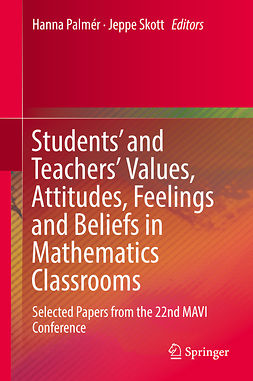Helenius, Ola
Mathematics Education in the Early Years
Part I. Introduction
1. Introduction
Ola Helenius, Maria L. Johansson, Troels Lange, Tamsin Meaney, Anna Wernberg
2. A Historical Overview of Early Education Policy and Pedagogy: Global Perspectives and Particular Examples
Helen May
Part II. Family and Transitions
3. Can Values Awareness Help Teachers and Parents Transition Preschool Learners into Mathematics Learning?
Alan J. Bishop
4. Negotiating with Family Members in a Block Play
Ergi Acar Bayraktar
5. Mathematical Understanding in Transition from Kindergarten to Primary School: Play as Bridge Between Two Educational Institutions
Dorothea Tubach, Marcus Nührenbörger
6. Investigating the Potential of the Home Learning Environment for Early Mathematics Learning: First Results of an Intervention Study with Kindergarten Children
Julia Streit-Lehmann, Andrea Peter-Koop
7. The Impact on Learning When Families and Educators Act Together to Assist Young Children to Notice, Explore and Discuss Mathematics
Ann Gervasoni, Bob Perry
Part III. Mathematical Processes
8. When Is Young Children’s Play Mathematical?
Ola Helenius, Maria L. Johansson, Troels Lange, Tamsin Meaney, Eva Riesbeck, Anna Wernberg
9. Two Frameworks for Mathematical Reasoning at Preschool Level
Lovisa Sumpter
10. Adaptability as a Developmental Aspect of Mathematical Thinking in the Early Years
Götz Krummheuer, Marcus Schütte
11. “Similar and Equal…”: Mathematically Creative Reflections About Solids of Children with Different Attachment Patterns
Melanie Beck
12. Children’s Play as a Starting Point for Teaching Shapes and Patterns in the Preschool
Kerstin Bäckman
13. Preschool Children Learning Mathematical Thinking on Interactive Tables
Dorota Lembrér, Tamsin Meaney
14. What Is the Difference? Young Children Learning Mathematics Through Problem Solving
Hanna Palmér
Part IV. Mathematical Content
15. Playing with Patterns: Conclusions from a Learning Study with Toddlers
Camilla Björklund
16. Development of a Flexible Understanding of Place Value
Silke Ladel, Ulrich Kortenkamp
17. The Relationship Between Equivalence and Equality in a Nonsymbolic Context with Regard to Algebraic Thinking in Young Children
Nathalie Silvia Anwandter Cuellar, Manon Boily, Geneviève Lessard, Danielle Mailhot
18. Developing a Mathematically Rich Environment for 3-Year-Old Children: The Case of Geometry
Pessia Tsamir, Dina Tirosh, Esther Levenson, Ruthi Barkai, Michal Tabach
19. MaiKe: A New App for Mathematics in Kindergarten
Anna Susanne Steinweg
20. “I Spy with My Little Eye”: Children Comparing Lengths Indirectly
Johanna Zöllner, Christiane Benz
21. The Role of Conceptual Subitising in the Development of Foundational Number Sense
Judy Sayers, Paul Andrews, Lisa Björklund Boistrup
Part V. Professional Development
22. Teachers’ Interpretation of Mathematics Goals in Swedish Preschools
Laurence Delacour
23. Reflection: An Opportunity to Address Different Aspects of Professional Competencies in Mathematics Education
Christiane Benz
Avainsanat: Education, Mathematics Education, Learning & Instruction
- Toimittaja
- Helenius, Ola
- Johansson, Maria L.
- Lange, Troels
- Meaney, Tamsin
- Wernberg, Anna
- Julkaisija
- Springer
- Julkaisuvuosi
- 2016
- Kieli
- en
- Painos
- 1st ed. 2016
- Sivumäärä
- 15 sivua
- Kategoria
- Kasvatus, opetus
- Tiedostomuoto
- E-kirja
- eISBN (PDF)
- 9783319239354
- Painetun ISBN
- 978-3-319-23933-0











